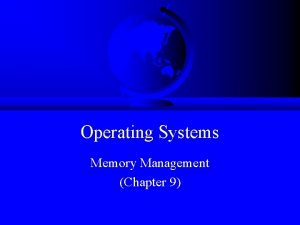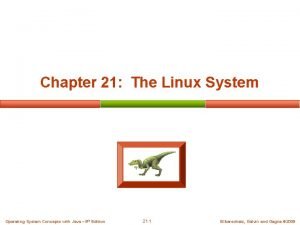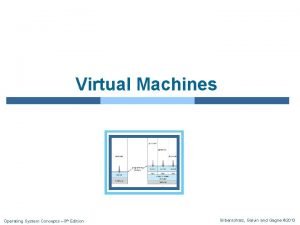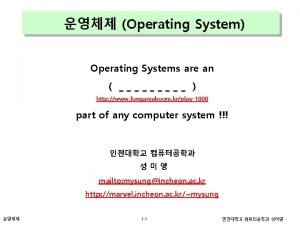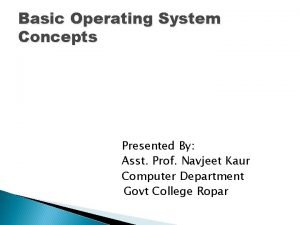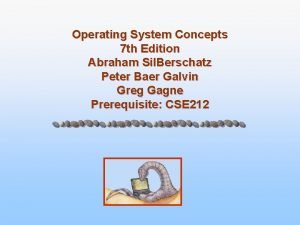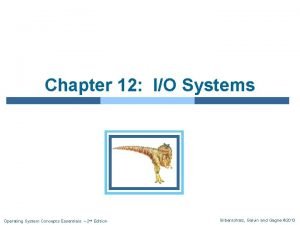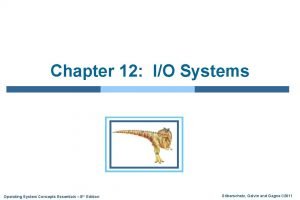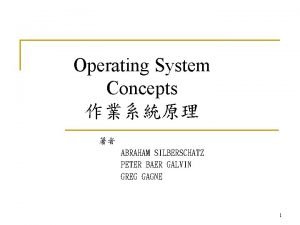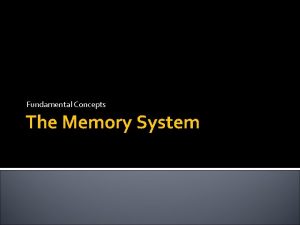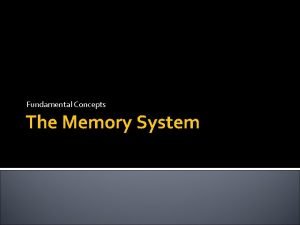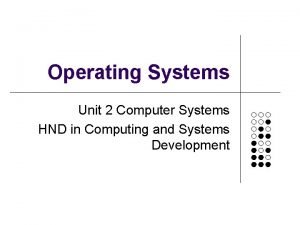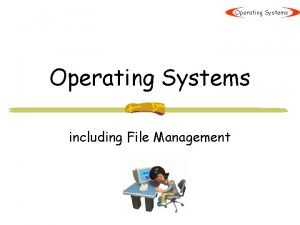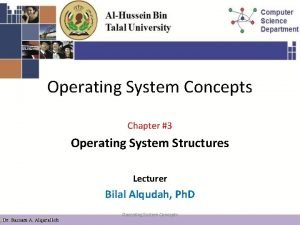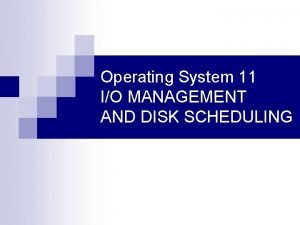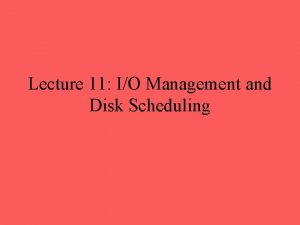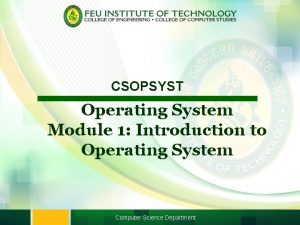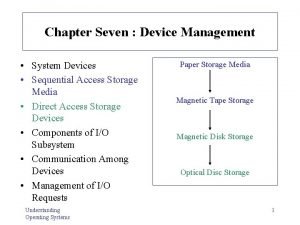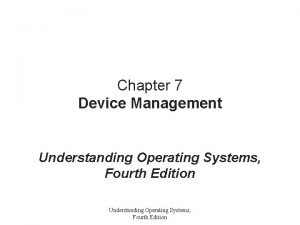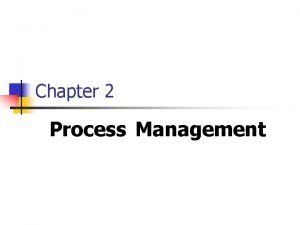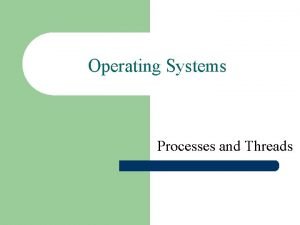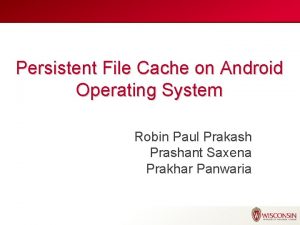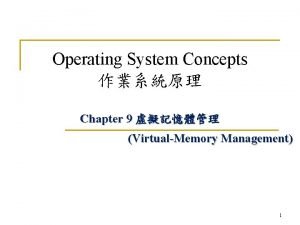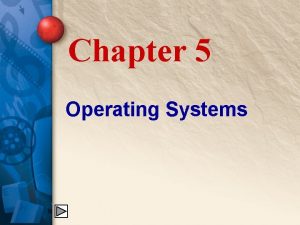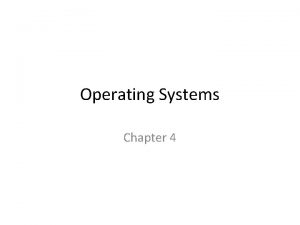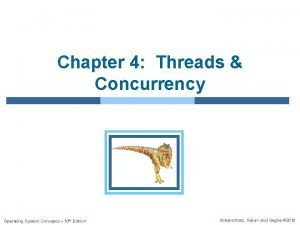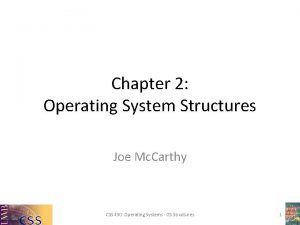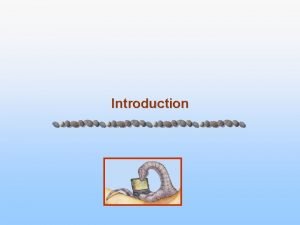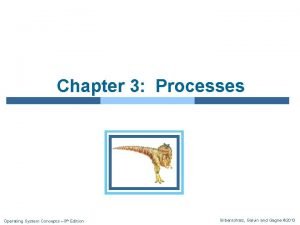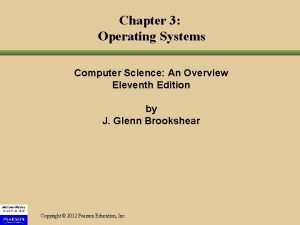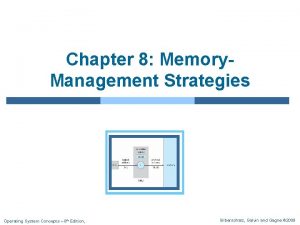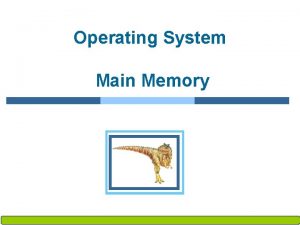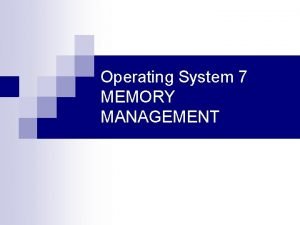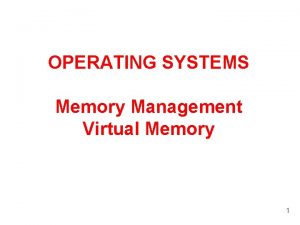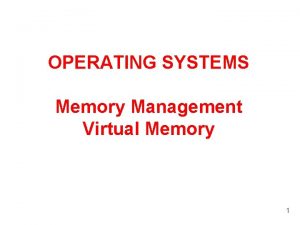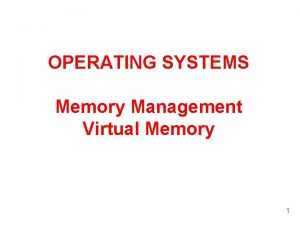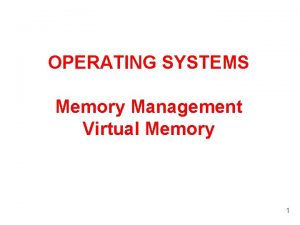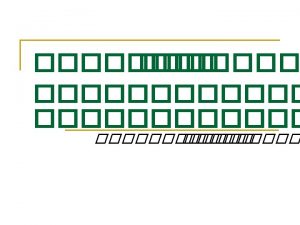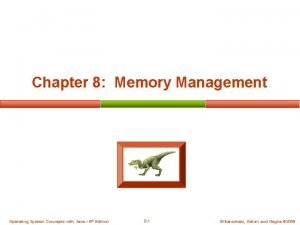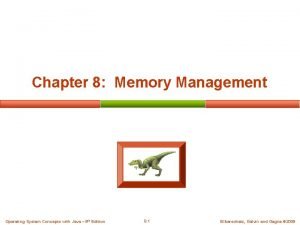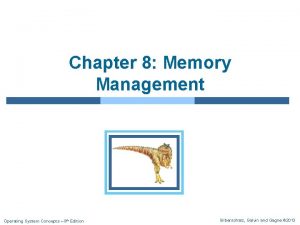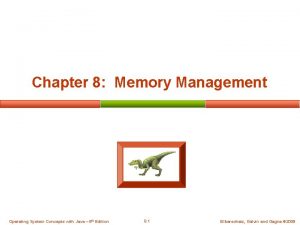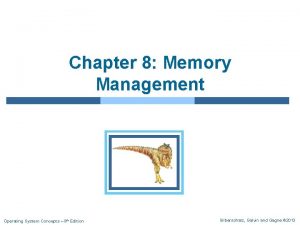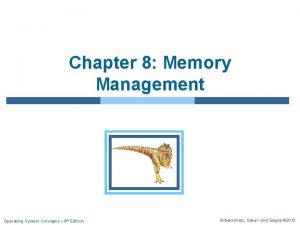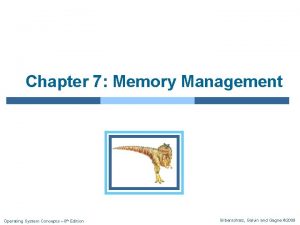Chapter 8 Memory Management Strategies Operating System Concepts
































































- Slides: 64

Chapter 8: Memory Management Strategies Operating System Concepts – 8 th Edition Silberschatz, Galvin and Gagne © 2009

Chapter 8: Memory Management Strategies n Background n Swapping n Contiguous Memory Allocation n Paging n Structure of the Page Table n Segmentation Operating System Concepts – 8 th Edition 7. 2 Silberschatz, Galvin and Gagne © 2009

Objectives n To provide a detailed description of various ways of organizing memory hardware n To discuss various memory-management techniques, including paging and segmentation Operating System Concepts – 8 th Edition 7. 3 Silberschatz, Galvin and Gagne © 2009

Background Operating System Concepts – 8 th Edition 7. 4 Silberschatz, Galvin and Gagne © 2009

Background § Memory is central to the operation of a modern computer system. § Memory consists of a large array of words or bytes, each with its own address § Selection of a memory-management method for a specific system depends on many factors, especially on the hardware design of the system. Operating System Concepts – 8 th Edition 7. 5 Silberschatz, Galvin and Gagne © 2009

Basic Hardware n Main memory , registers and cash are ONLY storage CPU can access directly n Program must be brought (from disk) into memory and placed within a process for it to be run n Direct storage access time: Huge problem… because of the frequency of memory accesses. 4 Register access in one CPU clock (or less) 4 Main memory can take many cycles (i. e. slowly) 4 Solution: Cache (fast memory) sits between main memory and CPU registers n Protection of memory: 4 Protection of memory is necessary to ensure correct operation 4 Protection from what (/possible risks)? ? – protect the operating system from access by user processes – protect user processes from one another. 4 This protection must be provided by the hardware &can be implemented in several ways. Operating System Concepts – 8 th Edition 7. 6 Silberschatz, Galvin and Gagne © 2009

Basic Hardware (Cont. ) n One method to implement protection: use Base and Limit Registers n We need to make sure that each process has a separate memory space…. How? ? ? l Main idea: we need to determine the range of legal addresses that can be accessed only by the process. 4 We can provide this protection by using two registers (base & limit) – The base register>> holds the physical address of the first byte in the legal range. – The limit register >> holds the size of the range. Operating System Concepts – 8 th Edition 7. 7 Silberschatz, Galvin and Gagne © 2009

Basic Hardware (Cont. ) – Example: If the base register holds 300040 and the limit register is 120900…. what is the range of legal addresses ? ? » The program can legally access all addresses from 300040 through 420939 (inclusive) » NOTE: Last physical address = base +limit -1 Operating System Concepts – 8 th Edition 7. 8 Silberschatz, Galvin and Gagne © 2009

Basic Hardware (Cont. ) n How base & limit registers help to provide memory protection? ? n By applying (2) procedures: Procedure (1): The CPU hardware compare every address generated in user mode with the registers. – Procedure (2): restrict the ability to load base & limit registers only to OS. . – Operating System Concepts – 8 th Edition 7. 9 Silberschatz, Galvin and Gagne © 2009

Basic Hardware (Cont. ) n Procedure (1): The CPU hardware compare every address generated in user mode with the registers. 4 If (CPU generated address ≥ base) & (CPU generated address < base +limit) … – Then …. . the CPU generated address is legal and allowed to access the memory – Else…… the CPU generated address is illegal and NOT allowed to access the memory…. . (causing a trap (/error) to OS) n This scheme prevents a user program from (accidentally or deliberately) modifying the code or data structures of either the operating system or other users…. . (solution to protection problem) Operating System Concepts – 8 th Edition 7. 10 Silberschatz, Galvin and Gagne © 2009

Basic Hardware (Cont. ) Fig. (8. 2): Hardware address protection with base and limit registers Operating System Concepts – 8 th Edition 7. 11 Silberschatz, Galvin and Gagne © 2009

Basic Hardware (Cont. ) n Procedure (2): restrict the ability to load base & limit registers ONLY to OS. n This restriction applied by using a special privileged instruction. n Since privileged instructions can be executed only in kernel mode, and since only the operating system executes in kernel mode…. . So, ONLY the operating system can load the base and limit registers. n This scheme allows the operating system to change the value of the registers but prevents user programs from changing the registers’ contents. Operating System Concepts – 8 th Edition 7. 12 Silberschatz, Galvin and Gagne © 2009

Address Binding n Address binding( or relocation): The process of associating program instructions and data to physical memory addresses n A user program will go through several steps -some of which may be optional-before being executed …. . ( steps are: compiling>>> linking>>>execution) n Addresses may be represented in different ways during these steps. l Addresses in the source program are generally symbolic (such as count, sum). l A compiler will typically bind these symbolic addresses to relocatable addresses (such as "14 bytes from the beginning of this module"). l The linkage editor or loader will in turn bind the relocatable addresses to absolute addresses (physical address) (such as 74014). n Each binding is a mapping from one address space to another. Operating System Concepts – 8 th Edition 7. 13 Silberschatz, Galvin and Gagne © 2009

Address Binding (cont. ) Figure 8. 3: Multistep processing of a user program. Operating System Concepts – 8 th Edition 7. 14 Silberschatz, Galvin and Gagne © 2009

Address Binding (cont. ) n The binding of instructions and data to memory addresses can be done at any step along the way: l Compile time. The compiler translates symbolic addresses to absolute addresses. If you know at compile time where the process will reside in memory, then absolute code can be generated (Static). l Load time : When it is not known at compile time where the process will reside in memory, then The compiler translates symbolic addresses to relative (relocatable) addresses. The loader translates these to absolute addresses (Static). l Execution time. If the process can be moved during its execution from one memory segment to another, then binding must be delayed until run time. The absolute addresses are generated by specialhardware (e. g. MMU) 4 Most general-purpose OSs use this method (Dynamic). n Static-new locations are determined before execution. n Dynamic-new locations are determined during execution. Operating System Concepts – 8 th Edition 7. 15 Silberschatz, Galvin and Gagne © 2009

Logical vs. Physical Address Space n Logical/virtual address: address generated by CPU n Physical address: address seen by memory hardware n Compile-time / load-time binding >>> logical address = physical address n Run-time binding >>> logical address≠ physical address l Logical address space: is the set of all logical addresses generated by a program l Physical address space: is the set of all physical addresses corresponding to these logical addresses. l MMU (Memory-Management Unit ): h/w device that maps virtual addresses to physical addresses at run time l Different methods of address mapping (/memory management strategies): 4 Continuous memory allocation 4 Paging 4 segmentation Operating System Concepts – 8 th Edition 7. 16 Silberschatz, Galvin and Gagne © 2009

Simple Address Mapping Method n For NOW, we illustrate address mapping with a simple MMU scheme: l The base register is now called a relocation register. l Basic methodology>>>> Physical address= logical address + relocation register l For example: 4 Base register contains 14000 4 If logical address =0 >>>> Physical address= 0+14000=14000 4 If logical address =346 >>>> Physical address= 346+14000=14346 n The user program never sees the real physical addresses. The user program deals with logical addresses. MMU converts logical addresses into physical addresses. Operating System Concepts – 8 th Edition 7. 17 Silberschatz, Galvin and Gagne © 2009

Example of Simple Address Mapping Method Operating System Concepts – 8 th Edition 7. 18 Silberschatz, Galvin and Gagne © 2009

Swapping Operating System Concepts – 8 th Edition 7. 19 Silberschatz, Galvin and Gagne © 2009

Swapping n Swapping is a mechanism in which a process can be swapped temporarily out of main memory to a backing store , and then brought back into memory for continued execution. n Backing store is a usually a hard disk drive or any other secondary storage which fast in access and large. Operating System Concepts – 8 th Edition 7. 20 Silberschatz, Galvin and Gagne © 2009

Swapping (Cont. ) n How swapping performed? ? ? l The system maintains a ready queue consisting of all processes whose memory images are on the backing store or in memory and are ready to run. l Whenever the CPU scheduler decides to execute a process, it calls the dispatcher. l The dispatcher checks to see whether the next process in the queue is in memory. l If it is not, and if there is no free memory region, the dispatcher swaps out a process currently in memory and swaps in the desired process. l Then, Dispatcher reloads registers and transfers control to the selected process. n n Major time consuming part of swapping is transfer time Total transfer time ∝ amount of memory swapped. n Context-switch time in such a swapping system is high. n Swapping is normally disabled but will start if many processes are running and are using a threshold amount of memory. n Swapping is again halted when the load on the system is reduced. Operating System Concepts – 8 th Edition 7. 21 Silberschatz, Galvin and Gagne © 2009

Basic Memory Management Methods Operating System Concepts – 8 th Edition 7. 22 Silberschatz, Galvin and Gagne © 2009

Basic Memory Management schemes Mem. Manegment schems (/strategies) Paging Continuous Allocation Multiple-partition method (Fixed-partition allocation) variable size method Conventional paging (basic method) Hierarchical Page Segmentation Hashed Page Inverted Page >>>>These strategies can also be combined. Operating System Concepts – 8 th Edition 7. 23 Silberschatz, Galvin and Gagne © 2009

Memory Management Strategy #(1): Contiguous Memory Allocation Operating System Concepts – 8 th Edition 7. 24 Silberschatz, Galvin and Gagne © 2009

Contiguous Memory Allocation (CMA) n The memory is usually divided into two partitions: l One for the resident OS l One for the user processes. n We can place the OS in either low memory or high memory. n Basic methodology: l Each process is contained in a single contiguous section of memory. n CMA strategy can be applied in (2) methods: l Multiple-partition method/(Fixed-partition allocation) method l variable-partition allocation method Operating System Concepts – 8 th Edition 7. 25 Silberschatz, Galvin and Gagne © 2009

Memory Allocation n Method #(1): Multiple-partition method (/Fixed-partition method) l Main idea: divide memory into several fixed-sized partitions. Each partition may contain exactly one process. l . In this multiple-partition method: 4 When a partition is free, a process is selected from the input queue and is loaded into the free partition. 4 When the process terminates, the partition becomes available for another process. l The degree of multiprogramming is bound by the number of partitions l One of the simplest methods for allocating memory l This method is called (Multiprogramming with a Fixed number of Tasks/ MFT) l This method is no longer in use Operating System Concepts – 8 th Edition 7. 26 Silberschatz, Galvin and Gagne © 2009

Memory Allocation (cont. ) n Method #(2): variable-partition method: l Memory is divided into variable-sized partitions l OS maintains a list of allocated / free partitions (holes) l When a process arrives, it is allocated memory from a hole large enough to accommodate it l Memory is allocated to processes until requirements of next process in queue cannot be met l OS may skip down the queue to allocate memory to a smaller process that fits in available memory l When process exits, memory is returned to the set of holes and merged with adjacent holes, if any l The method is a generalization of the fixed-partition scheme (called Multiprogramming with a Variable number of Tasks (MVT)) Operating System Concepts – 8 th Edition 7. 27 Silberschatz, Galvin and Gagne © 2009

Memory Allocation (cont. ) n Example: Operating System Concepts – 8 th Edition 7. 28 Silberschatz, Galvin and Gagne © 2009

Memory Allocation (cont. ) n New problem appear in variable-partition method…(how to satisfy a request of size (n) from a list of free holes? ? ? ) n There are many solutions to this problem: l l First fit. 4 Allocate the first hole that is big enough. 4 Searching can start either at the beginning of the set of holes or where the previous first -fit search ended. We can stop searching as soon as we find a free hole that is large enough. Best fit 4 4 4 l Allocate the smallest hole that is big enough. We must search the entire list, unless the list is ordered by size. This strategy produces the smallest leftover hole. Worst fit. 4 Allocate the largest hole. 4 we must search the entire list, unless it is sorted by size. 4 This strategy produces the largest leftover hole, which may be more useful than the smaller leftover hole from a best-fit approach. Operating System Concepts – 8 th Edition 7. 29 Silberschatz, Galvin and Gagne © 2009

Memory Allocation (cont. ) n Exercise (8. 16): Given five memory partitions of 100 KB, 500 KB, 200 KB, 300 KB, and 600 KB (in order), how would each of the first-fit, best-fit, and worst-fit algorithms place processes of 212 KB, 417 KB, 112 KB, and 426 KB (in order)? Which algorithm makes the most efficient use of memory? >>> Let p 1, p 2, p 3 & p 4 are the names of the processes Best-fit: First-fit: P 1>>> 100, 500, 200, 300, 600 P 2>>> 100, 288, 200, 300, 600 P 3>>> 100, 288, 200, 300, 183 100, 116, 200, 300, 183 P 4 (426 K) must wait final set of holes P 1>>> 100, 500, 200, 300, 600 P 2>>> 100, 500, 200, 88, 600 P 3>>> 100, 83, 200, 88, 600 P 4>>> 100, 83, 88, 600 100, 83, 88, 174 Worst-fit: P 1>>> 100, 500, 200, 300, 600 P 2>>> 100, 500, 200, 388 P 3>>> 100, 83, 200, 388 100, 83, 200, 300, 276 << final set of hole P 4 (426 K) must wait >>> In this example, Best-fit turns out to be the best because there is no wait processes. Operating System Concepts – 8 th Edition 7. 30 Silberschatz, Galvin and Gagne © 2009

Memory Allocation (cont. ) n In general witch algorithm (first-fit, best-fit, or worst-fit) is better? l Both first fit and best fit are better than worst fit in terms of decreasing time and storage utilization. l Neither first fit nor best fit is clearly better than the other in terms of storage utilization, but first fit is generally faster (because it doesn’t require full list search or sorting) Operating System Concepts – 8 th Edition 7. 31 Silberschatz, Galvin and Gagne © 2009

Fragmentation n Fragmentation is a problem appears in memory allocation censers about unusable memory space. n Fragmentation types: l l External fragmentation: memory space to satisfy a request is available, but is not contiguous…(i. e. storage is fragmented into a large number of small holes) 4 Both the first-fit and best-fit strategies for memory allocation suffer from external fragmentation. 4 (1/3) of memory may be unusable!!! Internal Fragmentation: allocated memory may be larger than requested memory…. (i. e. some memory within partition may be left unused) Operating System Concepts – 8 th Edition 7. 32 Silberschatz, Galvin and Gagne © 2009

Fragmentation (Cont. ) n External fragmentation solution: l l Compaction: Memory contents shuffled to place all free memory together in one large block 4 Dynamic relocation (run-time binding) needed 4 Compaction is expensive (high overhead) Permit the logical address space of the processes to be noncontiguous, thus allowing a process to be allocated physical memory wherever it is available. 4 Two techniques achieve this solution: – Paging – Segmentation Operating System Concepts – 8 th Edition 7. 33 Silberschatz, Galvin and Gagne © 2009

Fragmentation in Continuous memory allocation scheme n fixed-partition method suffer from internal fragmentation n variable-partition method suffer from external fragmentation Operating System Concepts – 8 th Edition 7. 34 Silberschatz, Galvin and Gagne © 2009

Memory Management Strategy #(2): Paging Operating System Concepts – 8 th Edition 7. 35 Silberschatz, Galvin and Gagne © 2009

Paging n Paging is a memory-management scheme that permits the physical address space of a process to be non-contiguous. n Because of its advantages, paging in its various forms is commonly used in most OSs. n Recent designs have implemented paging by closely integrating the hardware and OS, especially on 64 -bit microprocessors. n Paging method also used to manage backing store (e. g. hard disk). Operating System Concepts – 8 th Edition 7. 36 Silberschatz, Galvin and Gagne © 2009

Paging: Basic Method n The basic methodology: l Breaking physical memory into fixed-sized blocks called frames l Breaking logical memory into blocks called pages… Where (frame size= page size) n When a process is to be executed, its pages are loaded into any available memory frames from the backing store. n The backing store is divided into fixed-sized blocks that are of the same size as the memory frames. n OS keeps track of free frames. n Page table translates logical page to physical frame addresses n Frame size: l Defined by hardware l Should be power of 2 l Usually between 512 byte- 16 MB Operating System Concepts – 8 th Edition 7. 37 Silberschatz, Galvin and Gagne © 2009

Paging: Basic Method (cont. ) Figure 8. 8 Paging model of logical and physical memory. Operating System Concepts – 8 th Edition 7. 38 Silberschatz, Galvin and Gagne © 2009

Paging: Basic Method (cont. ) n Address generated by CPU is divided into: l Page number (p) – used as an index into a page table which contains the corresponding frame number l Page offset (d) – is the displacement within the page. l Where: 4 m= number of bits in logical address 4 n= number of bits in offset part 4 m-n= number of bits in page number part Operating System Concepts – 8 th Edition 7. 39 Silberschatz, Galvin and Gagne © 2009

Paging: Basic Method (cont. ) n Example: Given: Page# 0 Frame #0 Page# 1 Frame #1 n=2 bits m=4 bits Page# 2 Frame #2 Page# 3 Frame #3 Page size=4 B Physical mem. Size=32 B # of pages= 8 pages >> Convert the logical address (13) to physical address. Base address is the physical address of first byte in the target frame >>How to convert from logical address to physical address in paging? ? ? Physical address = base address+ offset = (frame # * frame size) + offset Operating System Concepts – 8 th Edition 7. 40 . . Frame #7 Silberschatz, Galvin and Gagne © 2009

Paging: Basic Method (cont. ) n Example. (Cont. ): Given: n= 2 bits m= 4 bits Page size=4 B Physical mem. Size=32 B # of pages= 8 pages >> Convert the logical address (13) to physical address. Physical address = base address+ offset = (frame # * frame size) + offset Logical address= 13 (in decimal) = (1101) in binary Page # = (11) = 3 Offset= (01)= 1 By using the page table>>> frame # = 2 >>> Physical address of logical address (13) =(2* 4) + 1=9 Exercise: Convert the following logical addresses (given in decimal) to physical for the same example: (0, 4, 10, 15) Operating System Concepts – 8 th Edition 7. 41 Silberschatz, Galvin and Gagne © 2009

Paging Arithmetic Laws >>How to convert from logical address to physical address in paging? ? ? Physical address = base address+ offset = (frame # * frame size) + offset n Page size = frame size n Logical address space (/size) = 2 m n Physical address space (/size) = 2 x (where x is the number of bits in physical address) n Logical address space (/size) = # of pages × page size n Physical address space (/size) = # of frames × frame size n Page size= frame size= 2 n n # of pages= 2 m-n n # of entries (records)in page table = # of pages n Required number of pages for a process = process size/ page size (Rounded up) Operating System Concepts – 8 th Edition 7. 42 Silberschatz, Galvin and Gagne © 2009

Paging: Basic method(Cont. ) Frame allocation procedure: n When a process arrives in the system to be executed: l Process size ( expressed in pages) is examined. …(i. e. if the process requires (n) pages, at least (n) frames must be available in memory) l If (n) frames are available>>> they are allocated …then, when a page is loaded into a frame, its frame number is put into the page table for this process…. and so on. Figure 8. 10 Free frames (a) before allocation and (b) after allocation Operating System Concepts – 8 th Edition 7. 43 Silberschatz, Galvin and Gagne © 2009

Paging: Basic Method (cont. ) n Paging scheme has NO external fragmentation. . but it has an internal fragmentation n Example: If process (p 1) size= 1030 B , page size= 512 B. . How many pages P 1 will occupied? ? l Required # of pages= 1030/512≈ 2. 01 3 pages l Notice that the last page is almost empty…. (506 bytes are allocated and unused)……. (Internal fragmentation)…. what is the solution? ? l Make page size small to reduce the internal fragmentation<<<<<Unsuitable solution because: 4 Page table size will increased…(more memory consumption & moreover head) 4 Disk I/O is more efficient when the amount data being transferred is larger n Generally, page sizes have grown over time as processes, datasets, and main memory have become larger. Operating System Concepts – 8 th Edition 7. 44 Silberschatz, Galvin and Gagne © 2009

Paging: Basic Method (cont. ) n Page table: l Part of process control block (PCB) l Each process has one page table l Contains 1 entry per logical page l Used to translate logical addresses to physical addresses in software n OS keep track of physical memory allocation by using a frame table n Frame table: l Maintained by OS l Contains 1 entry per physical frame 4 Whether free or allocated 4 If allocated>>> it contains allocation information (Process ID, page#) Operating System Concepts – 8 th Edition 7. 45 Silberschatz, Galvin and Gagne © 2009

Paging hardware n The hardware implementation of the page table can be done in several ways. n Different methods to implement (/store) the page table(PT): l l Method (1): Storing PT in dedicated registers: 4 The simplest case 4 Page table is stored in a set of dedicated, high-speed registers 4 Instructions to load/modify PT registers are privileged 4 Acceptable solution if page table is small Method (2): Storing whole PT in RAM : 4 This method is used if PT is large (common) 4 PT stored in main memory 4 Base address of PT is stored in page table base register (PTBR) 4 Context switch involves changing (1) register only (i. e. fast) 4 Two physical memory accesses are needed per user memory access (one for the page-table entry, one for the byte). – memory access is slowed by factor of 2>>> this delay is unacceptable!! Operating System Concepts – 8 th Edition 7. 46 Silberschatz, Galvin and Gagne © 2009

Paging hardware (Cont. ) l Method (3): Use a cash (TLB): 4 Use a special, small, fast cache, called a Translation Look-aside Buffer (TLB). 4 The search is fast but the hardware is expensive. 4 TLB holds subset of page table entries 4 Each entry in the TLB consists of two parts: a key (page #) and a value (frame #) 4 Input value (logical address(L. A. )) is compared simultaneously with all keys simultaneously. – If L. A is found (/ TLB hit ) >> corresponding value (frame #) is returned to calculate physical address (P. A. ) – If L. A is NOT found (/ TLB miss )>> » Access PT in RAM to get the frame# and then access RAM » The page # and frame # is added to TLB, so that they will be found quickly on the next reference. Operating System Concepts – 8 th Edition 7. 47 Silberschatz, Galvin and Gagne © 2009

Paging hardware (cont. ) Figure 8. 11 : Paging hardware with TLB. Operating System Concepts – 8 th Edition 7. 48 Silberschatz, Galvin and Gagne © 2009

Paging Hardware (Cont. ) n Hit ratio: percentage of times that a page# is found in TLB n Effective memory access time : average time for a memory access (including TLB lookup) n Example: l IF [ TLB lookup: 20 ns, Memory access time: 100 ns, Hit ratio: 80%]…Calculate the effective memory access time Ø If TLB hit >>> it takes (1) TLB access & (1) memory access Memory access time if TLB hit = 20+ 100 = 120 ns Ø If TLB miss >>> it takes (1) TLB access & (1) memory access to read PT & (1) memory access to access the desired byte Memory access time if TLB miss= 20+ 100 +100 = 220 ns Ø Hit ratio =80% >>> So, miss ratio= 20 % Effective access time = (0. 8 × 120) + (0. 2 × 220) = 140 ns Operating System Concepts – 8 th Edition 7. 49 Silberschatz, Galvin and Gagne © 2009

Protection in Paging n Memory protection in a paged environment is accomplished by protection bits associated with each frame. Normally, these bits are kept in the page table. n One bit can define a page to be read-write or read-only. l Every reference to memory goes through the page table to find the correct frame number. At the same time that the physical address is being computed, the protection bits is checked to verify that no writes are being made to a readonly page. l An attempt to write to a read-only page causes a hardware trap to the operating system n One additional bit is generally attached to each entry in the page table: a valid-invalid bit. l When this bit is set to ``valid''>>>the page is in the process's logical address space and is thus a legal (/ valid) page. l When the bit is set to ``invalid'‘>>> the page is not in the process's logical address space. l Illegal addresses are trapped by use of the valid-invalid bit. l The OS sets this bit for each page to allow or disallow access to the page. Operating System Concepts – 8 th Edition 7. 50 Silberschatz, Galvin and Gagne © 2009

Protection in Paging (Cont. ) n Example: Consider a system with a 14 -bit address space , we have a program that should use only addresses 0 to 10468. the page size is 2 KB. What are the valid pages for this program? ? m = 14 , , page size =2 KB= 2 11 B Logical address space = 2 m = 214 =16384 B Logical addresses range (0 - 16383) # of required pages I for this program= program size / page size = 10469 / 2 11 = 5. 11 ≈ 6 pages Valid pages for this program: pages # 0, 1, 2, 3, 4, 5. l Addresses in pages 0, 1, 2, 3, 4, and 5 are mapped normally through PT. l Any attempt to generate an address in pages 6 or 7>>> the computer will trap to the OS Operating System Concepts – 8 th Edition 7. 51 Silberschatz, Galvin and Gagne © 2009

Shared Pages n An advantage of paging is the possibility of sharing common code. This consideration is particularly important in a time-sharing environment. n Example: l Consider a system that supports 40 users, each of whom executes a text editor 4 If the text editor consists of 150 KB of code and 50 KB of data space, >>> we need 8, 000 KB to support the 40 users. 4 If the code shared>>> the required memory space =2, 150 KB n Only one copy of the editor need be kept in RAM. Each user's page table maps onto the same physical copy of the editor, but data pages are mapped onto different frames. n The code must be reentrant to be shareable …(Reentrant code is non-self- modifying code; it never changes during execution) Operating System Concepts – 8 th Edition 7. 52 Silberschatz, Galvin and Gagne © 2009

Shared Pages (Cont. ) Figure 8. 13 : Sharing of code in a paging environment. Operating System Concepts – 8 th Edition 7. 53 Silberschatz, Galvin and Gagne © 2009

Memory Management Strategy #(3): Segmentation Operating System Concepts – 8 th Edition 7. 54 Silberschatz, Galvin and Gagne © 2009

Segmentation n Users prefer to view memory as a collection of variable-sized segments, with no necessary ordering among segments. n Address space is made up of variable- sized logical segments e. g. main function, subroutines, some data structures (list, array, stack, etc. ), . . . n Segmentation is a memory- management scheme that supports the user view of memory. A logical address space is a collection of segments. Operating System Concepts – 8 th Edition 7. 55 Silberschatz, Galvin and Gagne © 2009

Segmentation (cont. ) n Each segment has a name and a length. The addresses specify both the segment name and the offset within the segment. n The user therefore specifies each address by two quantities: l a segment name …. (replaced by segment # for simplicity) l an offset n Logical addresses specify < segment identifier, offset > Operating System Concepts – 8 th Edition 7. 56 Silberschatz, Galvin and Gagne © 2009

Segmentation: Hardware n Segment Table l Segment Table used to convert from logical to physical addresses l Segment table entry = ( segment base, segment limit ) 4 Base = starting physical address of segment in memory 4 Limit = size of segment n Logical address consist of : l Segment number (s) -- segment number is used as an index into a segment table. l Segment offset (d)- segment offset is first checked against limit and then is combined with base address to define the physical memory address 4 The offset of the logical address must be between 0 and the segment limit. If it is not, we trap to the OS (logical addressing attempt beyond end of segment). . Operating System Concepts – 8 th Edition 7. 57 Silberschatz, Galvin and Gagne © 2009

Segmentation: Hardware (Cont. ) >>How to convert from logical address to physical address in segmentation? ? ? IF (offset < limit) then Physical address= base address+ offset Figure 8. 19: Segmentation hardware Else Trap (address error) Operating System Concepts – 8 th Edition 7. 58 Silberschatz, Galvin and Gagne © 2009

Segmentation: Hardware (Cont. ) n Example: Consider the segmentation system shown in the figure. . Convert the following logical addresses (given in decimal) to physical addresses. case(1): L. A. = 2, 53 IF (offset < limit) then Physical address= base address+ offset Else Trap (address error) Segment # =2 Offset= 53 Base= 4300 P. A. = 4300+53=4353 Operating System Concepts – 8 th Edition 7. 59 Silberschatz, Galvin and Gagne © 2009

Segmentation: Hardware (Cont. ) n Example. (Cont. ): case(2): L. A. = 0, 1222 IF (offset < limit) then Physical address= base address+ offset Else Trap (address error) Segment # = 0 Offset= 1222 Offset (1222) is not less than limit (1000) … So, it is illegal reference, trap to operating system Operating System Concepts – 8 th Edition 7. 60 Silberschatz, Galvin and Gagne © 2009

Segmentation n Segmentation suffer from external fragmentation Operating System Concepts – 8 th Edition 7. 61 Silberschatz, Galvin and Gagne © 2009

End of Chapter 8 Operating System Concepts – 8 th Edition Silberschatz, Galvin and Gagne © 2009

Helpful Information n The computer system has two modes of operation : n l User mode l Kernel mode (also called supervisor mode/ system mode/ privileged mode). There is a bit (mode bit) indicate the current mode: kernel (0) or user (1). n When the computer system is executing on behalf of a user application, the system is in user mode. n Whenever the operating system gains control of the computer, it is in kernel mode. n Only the operating system executes in kernel mode n Privileged instructions: are a machine code instructions that may only be executed when the processor is running in kernel mode. • Example of privileged instructions: I/O operations and interrupt management. • If an attempt is made to execute a privileged instruction in user mode>>> the hardware does not execute the instruction & traps it to the operating system. Operating System Concepts – 8 th Edition 7. 63 Silberschatz, Galvin and Gagne © 2009

Helpful Information n Fragmentation is a problem about unusable memory space. …. . (i. e. waste in memory) l Fragmentation types: 4 External fragmentation: memory space is NOT allocated and unused 4 Internal Fragmentation: memory space is allocated and unused Operating System Concepts – 8 th Edition 7. 64 Silberschatz, Galvin and Gagne © 2009
 Operating system concepts chapter 8 solutions
Operating system concepts chapter 8 solutions Operating system concepts chapter 5 solutions
Operating system concepts chapter 5 solutions Operating system concepts chapter 5 solutions
Operating system concepts chapter 5 solutions Memory management operating system
Memory management operating system Operating system concepts, 10th edition
Operating system concepts, 10th edition Linux operating system concepts
Linux operating system concepts Operating system concepts with java
Operating system concepts with java Operating system concepts 6th edition
Operating system concepts 6th edition Type 0 hypervisor
Type 0 hypervisor Real time operating system concepts
Real time operating system concepts Operating system concepts 9판 한국어판
Operating system concepts 9판 한국어판 Basic concepts of os
Basic concepts of os Operating system concepts 11th
Operating system concepts 11th Operating system concepts essentials
Operating system concepts essentials Operating system concepts essentials
Operating system concepts essentials Galvin os
Galvin os Promotional concepts and strategies
Promotional concepts and strategies Contrast trade promotions and consumer sales promotions
Contrast trade promotions and consumer sales promotions Memory management strategies
Memory management strategies Basic concepts of memory system
Basic concepts of memory system Demand paging in virtual memory
Demand paging in virtual memory Memory management in os
Memory management in os Operating systems
Operating systems Basic concepts of memory
Basic concepts of memory Database system concepts
Database system concepts Process management in operating system
Process management in operating system File management in operating system pdf
File management in operating system pdf Process management in operating system
Process management in operating system The unit is capable of mimicking the processor
The unit is capable of mimicking the processor Open source operating system
Open source operating system I/o device management in operating system
I/o device management in operating system Dual mode in os
Dual mode in os Sequential access device
Sequential access device I/o device management in operating system
I/o device management in operating system Process management in operating system
Process management in operating system Slidetodoc.com
Slidetodoc.com File management in android operating system
File management in android operating system File management in operating system
File management in operating system 輾轉現象
輾轉現象 Semantic prototype
Semantic prototype Explicit memory
Explicit memory Long term memory vs short term memory
Long term memory vs short term memory Internal memory and external memory
Internal memory and external memory Primary memory and secondary memory
Primary memory and secondary memory Logical memory vs physical memory
Logical memory vs physical memory Which memory is the actual working memory?
Which memory is the actual working memory? Virtual memory
Virtual memory Virtual memory in memory hierarchy consists of
Virtual memory in memory hierarchy consists of Eidetic memory vs iconic memory
Eidetic memory vs iconic memory Shared vs distributed memory
Shared vs distributed memory Buddy system example
Buddy system example File system in operating system
File system in operating system File system in operating system
File system in operating system File system in operating system
File system in operating system Network operating system types
Network operating system types Types of operating system
Types of operating system Chapter 4 operating system
Chapter 4 operating system Concurrency vs parallelism in os
Concurrency vs parallelism in os Windows operating system architecture
Windows operating system architecture Operating system chapter 1
Operating system chapter 1 Operating system chapter 3
Operating system chapter 3 Operating system chapter 3
Operating system chapter 3 Data management concepts
Data management concepts Clock and compass time management
Clock and compass time management Core concepts of management
Core concepts of management



